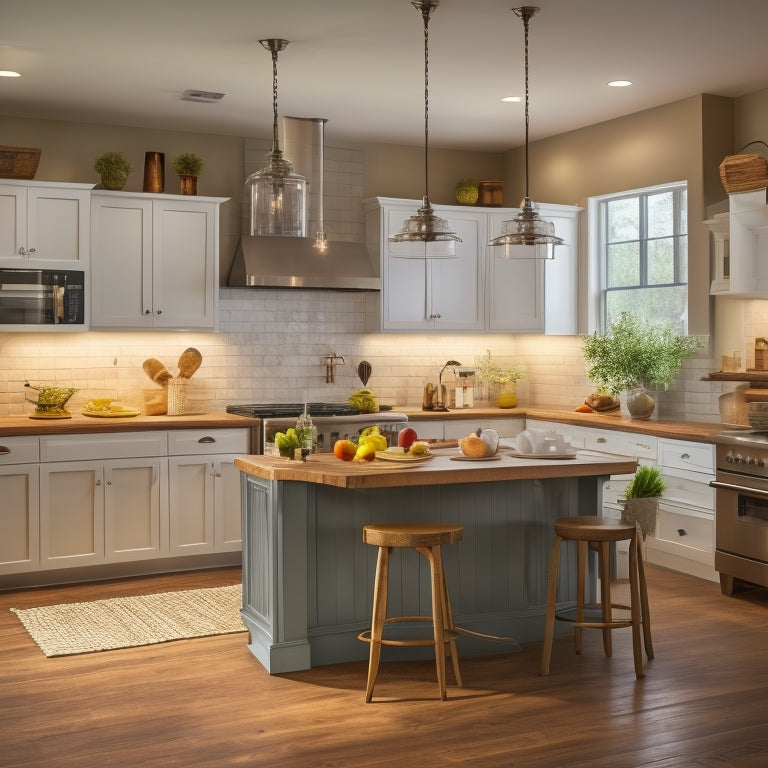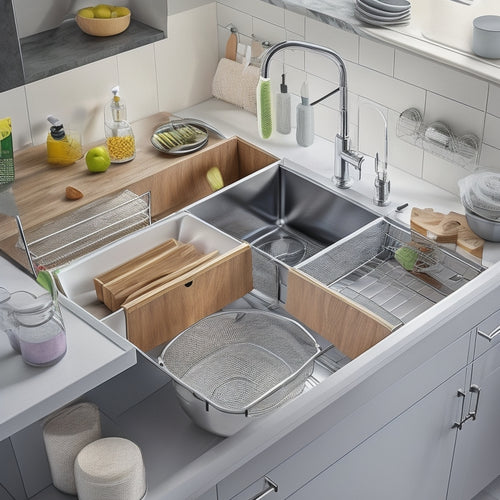
What Makes a Kitchen Truly Functional for You?
Share
You design a kitchen that truly functions for you by evaluating your unique needs, habits, and preferences. Identify essential features based on your cooking style, preferred methods, and frequency of use. Maximize storage and space by utilizing corner cabinets, pull-out shelves, and vertical storage. Optimize workflow and traffic by analyzing patterns and eliminating obstacles. Incorporate multifunctional elements, like hidden chargers and retractable appliances, to streamline your space. By adapting your kitchen to your lifestyle, you'll create a space that's tailored to your needs, enhances user experience, and makes cooking a breeze - and that's just the beginning of your kitchen transformation journey.
Key Takeaways
• A kitchen that accommodates your unique lifestyle and daily habits, incorporating features that cater to your personal preferences and needs.
• A well-planned layout that optimizes workflow and traffic, eliminating obstacles and ensuring efficient movement between tasks.
• Essential features and appliances that align with your cooking style, frequency, and preferred methods, making meal preparation a breeze.
• Ample and accessible storage that streamlines workflow, keeping countertops clear and frequently used items within easy reach.
• Multifunctional elements that enhance functionality, such as hidden chargers, retractable appliances, and modular cabinetry, to create a clutter-free and efficient space.
Assessing Your Kitchen Needs
Take inventory of your cooking habits and preferences to identify the essential features and functionalities your dream kitchen should have.
Think about your personal habits: do you cook frequently, or just occasionally? Do you have a large family to feed, or is it just you? Your answers will help determine the size and layout of your kitchen.
Consider your cooking style: are you a messy cook who needs ample counter space, or a tidy one who can get by with less? Do you have a favorite cooking method, like baking or grilling, that requires specific tools and appliances?
Think about the types of dishes you typically prepare and the utensils you need to make them. Do you prefer a gas stove or electric cooktop? Your cooking style will influence the types of appliances and features you need in your kitchen.
Maximizing Storage and Space
By strategically allocating space and incorporating clever storage solutions, you can transform your kitchen into a highly functional and efficient hub that accommodates all your cooking needs.
Corner cabinets are a great way to maximize storage, providing easy access to infrequently used items while keeping countertops clear. Consider installing pull-out shelves or lazy susans to make the most of these often-wasted spaces.
Meanwhile, vertical shelves can help you make the most of your kitchen's vertical space, keeping frequently used items within easy reach. You can install shelves above countertops, near windows, or even above appliances to create a sense of airiness while storing cookbooks, decorative items, or kitchen gadgets.
When planning your storage solutions, think about your cooking habits and the items you use most frequently. Store heavy items near the floor to maintain a sense of balance, and group similar items together to streamline your workflow.
Optimizing Workflow and Traffic
As you navigate your kitchen, consider the traffic patterns and workflow that will help you move efficiently between tasks, ensuring that every step, turn, and reach feels intuitive and streamlined.
Visualize yourself moving from the sink to the stove, then to the refrigerator, and back again. Identify the areas where you tend to pause or struggle, and think about how you can optimize the layout to eliminate these obstacles.
One common challenge is corner pinchpoints, where two countertops meet and create a narrow, hard-to-reach space. Consider installing a curved countertop or a clever corner solution to make the most of these areas.
Another key consideration is island placement. Will a central island create a comfortable workflow, or will it obstruct the path between key zones? Think about the 'work triangles' between your sink, stove, and refrigerator, and how an island can either enhance or disrupt these important paths.
Incorporating Multifunctional Elements
Incorporating multifunctional elements, like modular cabinetry or retractable appliances, can transform your kitchen into a dynamic, space-saving haven that effortlessly adapts to your changing needs. By thoughtfully integrating these elements, you'll create a kitchen that's not only visually stunning but also highly functional.
| Element | Description | Benefits |
|---|---|---|
| Hidden Chargers | Concealed outlets and USB ports | Clutter-free countertops, easy device charging |
| Flexible Islands | Moveable or adjustable islands | Increased counter space, improved workflow |
| Retractable Appliances | Appliances that slide or fold away | Streamlined countertops, reduced clutter |
| Modular Cabinetry | Interchangeable cabinet components | Customizable storage, flexible design |
| Multi-Height Counters | Counters with varying heights | Accommodates different tasks, comfortable working |
Adapting to Your Lifestyle
You'll want your kitchen to adapt to your unique lifestyle, whether you're a busy professional, a parent of three, or an avid entertainer, and that means designing a space that accommodates your daily habits and rituals.
For instance, if you're a morning person, you might want to prioritize natural light and a comfortable breakfast nook. On the other hand, if you're a night owl, you might prefer a kitchen that seamlessly shifts into evening mode, with dimmable lighting and a wine fridge.
As you design your kitchen, consider your personal preferences, from the type of appliances you prefer to the layout that works best for you. Age considerations are also essential, especially if you're planning to age in place.
For example, you might want to incorporate grab bars, non-slip flooring, and single-handle faucets to make sure your kitchen remains accessible and safe as you grow older. By tailoring your kitchen to your lifestyle, you'll create a space that not only looks beautiful but also feels like home.
Frequently Asked Questions
How Do I Balance Aesthetics With Functionality in My Kitchen Design?
You'll strike design harmony by marrying your personal style with functional needs, ensuring every element, from cabinetry to countertops, serves a purpose while reflecting your unique taste, creating a kitchen that's both beautiful and highly functional.
Can I Have a Functional Kitchen With a Small Budget for Renovation?
You can totally have a functional kitchen on a shoestring budget! Get creative with budget hacks like repurposing items, and DIY solutions like upcycling old furniture to create a space that's both beautiful and efficient.
Are Smart Appliances Worth the Investment for a Functional Kitchen?
"Blood is thicker than water," but when it comes to smart appliances, you're wondering if they're worth the investment. For you, energy efficiency and seamless integration are key; with smart appliances, you'll enjoy a streamlined cooking experience that's both eco-friendly and high-tech.
How Do I Ensure My Kitchen Remains Functional as I Age?
As you plan for the future, consider incorporating age-friendly cabinets with easy-grip handles and Universal design principles, ensuring your kitchen remains accessible and comfortable for you to navigate, cook, and socialize as you age.
Can a Functional Kitchen Be Achieved in a Non-Traditional Kitchen Space?
"You think a functional kitchen requires a sprawling space, but irony alert: micro kitchens in loft spaces can be über-functional! With intentional design, every inch can serve a purpose, making cooking and socializing a breeze, even in the tiniest of areas."
Related Posts
-

LYNK PROFESSIONAL: Transform Your Under-Sink Storage
Transform your under-sink storage with LYNK PROFESSIONAL, a cleverly designed system that tackles common challenges. ...
